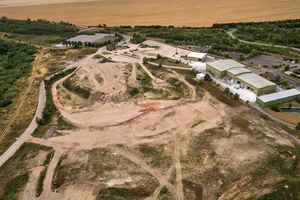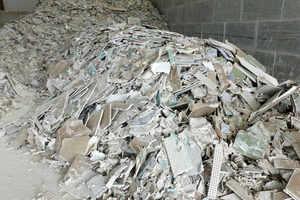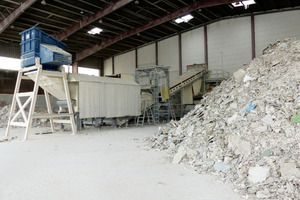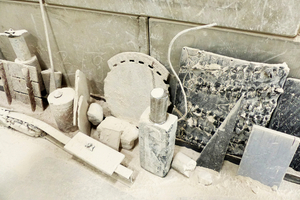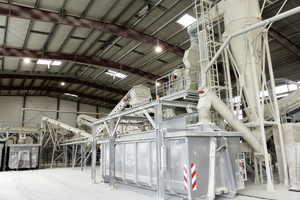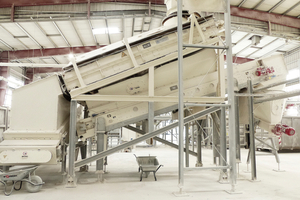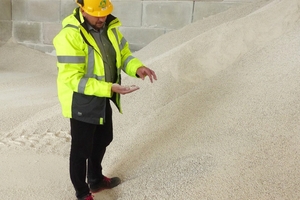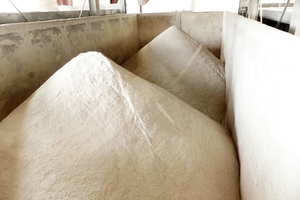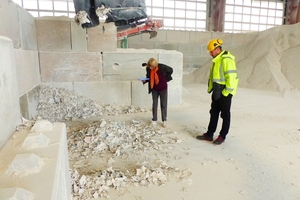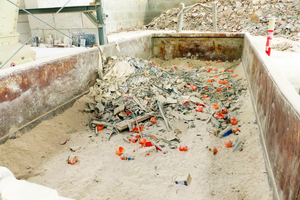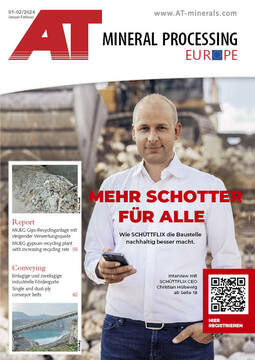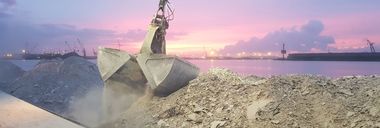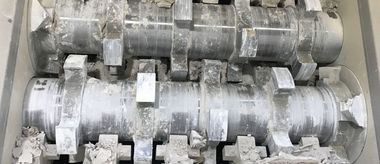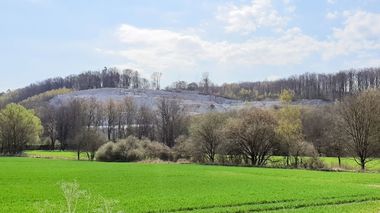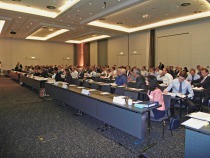MUEG Mitteldeutsche Umwelt und Entsorgung GmbH Grosspösna gypsum recycling plant
The Company
MUEG has its headquarters in Braunsbedra, on Lake Geiseltal, in Saxony-Anhalt. Some 220 employees work in five sectors (power-plant decommissioning/disposal, thermal-route valorisation, landfill/mining remediation and landfill construction, waste-water and recycled-materials preparation) and in the company’s own research department. The recycled-materials preparation division includes, inter alia, the gypsum recycling plant, which employs four persons.
Background
“There are, in truth, enough gypsum deposits in Germany, but they are found in karst districts with attractive unspoiled landscapes. FGD gypsum from flue-gas desulphurisation scrubbing in coal-fired power-generating plants has up to now been very much in demand. As such plants are taken off-grid in the next few years, however, much greater importance will attach to the recycling of gypsum waste,” reports Jörg-Michael Bunzel by way of introduction.
Although it has been possible in Germany to recycle plasterboard (aka drywall) waste since 2014, the project remains very much in its infancy. This is due not only to the fact that only relatively small amounts of plasterboard are available compared to other mass-produced materials in the field of construction waste, but also because the legally non-conformant route of dumping – frequently declared as valorisation – is selected instead of more complex and higher input materials-route recycling. A yield of 641 000 t/a of gypsum-containing waste is currently stated [1] for the whole of Germany in the relevant literature, of which, according to the data of the German Association of the Gypsum Industry, around 150 000 t/a can be recycled. An increase in this amount up to around 300 000 t/a is anticipated. The obtainment of reliable figures for the yield of used plasterboard is also complicated by the fact that separate collection and transportation of this waste is still not universal German practice.
A significant amount of gypsum waste was used for the capping of salt heaps in Thuringia in the years up to 2010/2011. This had to be discontinued, however, since the use of gypsum waste as a substitute building material for landfills is impermissible under Article 14, Para. 2 of the German Landfill Regulations (Deponieverordnung). In addition, the Commercial Waste Regulations (Gewerbeabfallverordnung) require that gypsum waste be separately collected at its point of production (i.e. the construction site itself) and routed to the highest possible grade of utilisation. Nonetheless, since 2014 the major part of gypsum waste yielded in Germany continues to be exported, primarily to the Czech Republic, and used there for the remediation of mining cavities (stabilisation of uranium-contaminated sludge landfills). That use, however, is a long way from the circular economy targeted in Germany (pseudo-valorisation) and has, in addition, also caused a drastic price slump on the German market.
Construction of the gypsum recycling plant
MUEG was established in 1990 in order to cope with the enormous disposal tasks facing the lignite-mining region of central Germany following the founding of MIBRAG Mitteldeutsche Braunkohlengesellschaft mbH (“Central Germany Lignite-Mining Corporation; in the following: MIBRAG). MIBRAG and Remondis Kommunale Dienste Ost GmbH held equal shareholdings in MUEG. As the legal stipulations became more stringent, and with the planned official prohibition of the deposition of gypsum-containing waste in mining areas (by the German states of Thuringia, Saxony and Baden-Württemberg, in particular), the company decided to construct a plant for the high-grade valorisation of such waste, the more so since there had up to now been no industrial-scale plant in Germany for the valorising treatment of this waste material. The pioneers in this field were companies from Denmark, the UK and Canada. In Germany, the German Association of the Gypsum Industry has also been active and in 2012 drafted a return-acceptance concept for gypsum waste. During this period, work also started on the construction of the Grosspösna recycling plant in the Störmthal district, the so-called “VEZ 1” (Valorisation and Disposal Centre 1). This received approval under the 17th. Prevention of Pollution Ordinance in 2013 and was commissioned in July 2014 as Germany’s first such stationary facility. In selecting Störmthal, the company chose an excellent strategic location, notable in particular for a whole number of advantages:
Direct access to the A38 autobahn
Company-own rail connection
Inland harbours at: Torgau around 80 km, Haldensleben around 180 km, Königs Wusterhausen around 220 km
To assure constantly high input, collecting points have been established in Asendorf, Beuna and Lochau, and also at regional disposal centres. This plant is the first gypsum recycling facility in Germany with so-called “approved-product” status – in other words, the recycled gypsum can be directly re-used in the gypsum industry. Of five such plants existing in Germany, four remain in operation.
Input material
The company has decided to process initially only plasterboard (Waste Code Number 17 08 02) – originating from both demolition projects and from production waste – since this material possesses very good recycling properties. Whether stored gypsum waste is also suitable as a feed material has not yet been conclusively researched. It is, however, even now apparent that this form of processing will probably be very complicated and costly. The gypsum industry’s quality standards are extremely high and can be met only if the disruptant content is very low, mineral disruptants being especially problematical. The corresponding acceptance criterion for disruptants in the MUEG plant amounts to ≤ 10 % by mass: suppliers and delivery personnel are obliged to guarantee these levels.
The recycling process
This gypsum recycling plant operates using a modified Irish process and is designed for a throughput of 75 000 t/a. This is a classical, purely mechanical process, and can still be further expanded. Essentially, a range of comminuting and grading stages are installed in line; processing takes place until the required purity and fineness are achieved. The comminution equipment must be very accurately tailored to the preparation process as a whole, in order to obtain a high-quality product [2]. In principle, breakdown comminution can be accomplished using high-speed crushers with a high energy input or using slow-running machines with a low energy uptake. The latter machines are less susceptible to operating problems and generate coarser particles that can be more easily separated out in the downstream grading stage. Fluctuating moisture contents in the feed material are also problematical, and can be balanced out a little by storing the material in dry conditions.
The recycling rate – referred to input quantity – is currently 85 %, but should be raised to 98 % in the near future, thanks to a further process modification.
The plasterboard waste delivered is stored in a building in two separate talus cones in quantities of 800 t to 1000 t (maximum storage capacity 2500 t) and then sampled and tested. Clearance is given for processing if the acceptance criteria are met. If this is not the case, preliminary sorting is necessary before the material can be cleared for processing. Disruptants range from plastics, including plastic films, via metals – in the form of cans, machined components, metal sheet, and many other items – wood, mineral waste, up to and including glass and ceramics. The curiosities to be found, which, however, can seriously disrupt the preparation process, can be seen in the attached photograph. They are, of course, manually removed, provided they can be seen.
Mechanical shovels are then used to feed the input material via a feed hopper to the first comminution stage for breaking down of coarser lumps. Any impurities also remain in coarse lumps, with the result that they can be better separated out, as explained above. Metallic impurities are removed by means of magnetic separators. The material then passes through further comminution stages and via a belt conveyor to the grading (or classifying) machine, in which both screens and various classifiers are used.
The products generated take the form of a recycled granulate, a recycled powder and a paper or cardboard fraction. The latter is firstly used for thermal-route recycling in a separate facility. The plant is currently being fitted with new equipment; this will make it possible to raise the purity of the paper fraction to such an extent that it can again be used for materials-route recycling. Of the final product – recycled gypsum – the two fractions mentioned above possess the same quality, and can thus equally be used for the purpose mentioned.
The plant is, it is true, approved for three-shift operation, but it has up to now only been operated on a single-shift basis, as a result of the insufficient amounts of gypsum waste available.
Cost-efficiency and future prospects
After nearly ten years in operation, recycling of plasterboard is now financed entirely from the disposal charges paid by the delivery personnel and by revenue from the sale of recycled gypsum. Not without reason, MUEG’s recycling plant is certified as a specialist disposal organisation and also in conformity to a range of ISO standards.
The plant’s cost-efficiency is also dependent on the haulage distances for gypsum waste, and the catchment area for the plant in Grosspösna should therefore not exceed approximately 200 km. The catchment area for the obtainment of plasterboard waste, which currently extends as far as Bavaria and Baden-Württemberg, could be reduced in size, thus permitting a decrease in transport costs. In view of the future more stringent legal requirements for adherence to the circular economy, including a prohibition of landfill dumping of recyclable waste, several more plants are planned. Gypsum-waste recycling is certainly effective, but there is still much to be done to achieve sustainability in the gypsum building materials sector throughout Germany.
The AT Mineral Processing team would like to thank for the comprehensive and detailed explanations as well as the interesting plant tour and wish the company continued success.
Literature:
[1] LAGA-Mitteilung, https://www.laga-online.de.documents vom 01.07.2022
[2] Bunzel, J.-M. u. Patrick Farago: Technische und logistische Konzepte zum Recycling von Gipskartonplatten, in: Mineralische Abfälle und Nebenprodukte, Bd. 10 (2023), S. 62 - 72, Thomé-Kozmiensky Verlag GmbH, Neuruppin
Dr. Brigitte Hoffmann, Consulting Kreislaufwirtschaft/
Umweltschutz, Oberschöna/Germany

